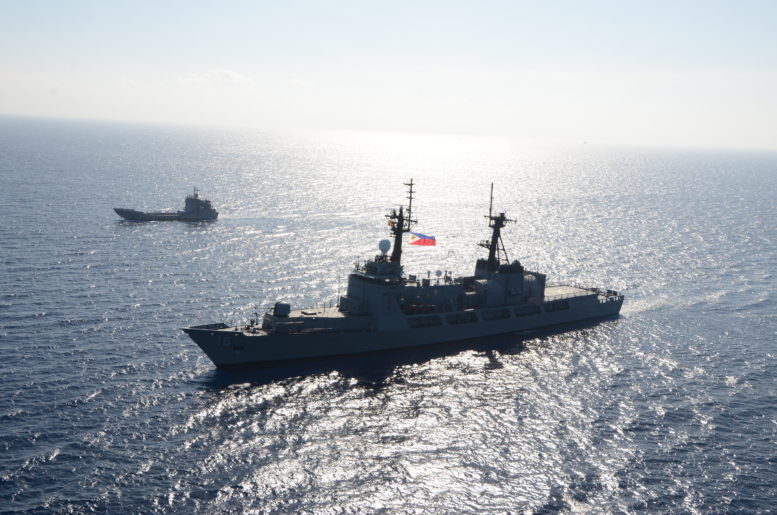We join the Philippine Navy in celebrating its 119th Founding Anniversary in May this year and convey our warmest congratulations for being an active partner in the maritime community and an instrument of peace, progress and stability. With its well-conceived plan of governance but still faced with inadequate resources we are tempted to ask the question: Is it on track in pursuing its vision to be a strong and credible navy that a maritime nation can be proud of by the year 2020?
The Philippine naval history may be divided into three periods. The first period was during the Philippine revolution (1898-1901). The seagoing force then only focused on troop transport in support to land forces fighting against the colonizers. It eventually disappeared when a new colonial power pretending to be a friend took control of the new republic and ruled the nation. The second period was during the Commonwealth era (1939-1941) when the National Defense Act took effect. The Army of the Philippines’ Offshore Patrol (OSP) unit welcomed WWII with 3 torpedo boats that were no match against an Imperial navy. The third period is the present navy (1947 onwards). Most of its hand-me-down combatant ships are old, augmented by not-so-old vessels from other countries. But even with these aging yet capable assets, the Navy’s command of the sea in the 1970s has never been challenged even at the height of the secessionist insurgency in Southern Philippines. In the 1990s, the Navy acquired new patrol gunboats and two logistics support vessels. This coincided with the departure of US forces resulting from the termination of RP-US military bases agreement and the end of bipolar security alignment.
Aware of the ever-changing security environment, the Navy in 2006 crafted a strategic plan, dubbed “PN Sail Plan 2020,” or “Navy 2020,” to address a variety of challenges in a multi-dimensional maritime domain. This plan adopted a Balanced Scorecard framework that connects strategic agenda such as vision, mission, and core values with operational elements like objectives, measures, targets and initiatives. To assure success, the Navy established a Center for Naval Leadership Excellence to keep track of the various components of the Sail Plan. On top of this, the Navy has convened a Board of Advisers consisting of civilians and former naval officers to assist in governance.
The Philippine Navy’s induction early this year into the Palladium Balanced Scorecard Hall of Fame for Executing Strategy speaks volumes of outstanding accomplishments. The Philippine Navy is one of the five Palladium Awardees for 2016 and the nation’s first national government agency to earn the prestigious award. It now joins 4 local government units in the Philippines and other 200 private, business and government organizations from 40 nations, including the US Army and the Portuguese Navy, since the inception of the award. Some of the notable achievements over a 10-year period include: increase by 33% in operational readiness, 29% in personnel readiness, and 14-fold in ISO-accredited units. The conferment makes the Navy a model outfit that other entities may study. The Navy’s planning efforts have gone a long way.
But there is much more the Navy must do to make it relevant and become the armed service of choice. “Don’t rest on your laurels,” as the saying goes. Peter The Great when activating the Imperial Russian Navy in 1696 declared: “States without navies are single-handed.” A century later George Washington in 1781 said: “It follows then, as certain as night succeeds day, that without a decisive naval force, we can do nothing definitive, and with it everything honorable and glorious.” Clearly, a maritime country needs a strong and credible navy.
With its multifarious tasks, one vital activity that the Navy must closely examine is acquiring platforms to effectively perform its mandate to train, equip, and maintain forces for naval defense. An equipment-intensive organization requires mastery of defense procurement laws, rules and regulations. In selecting the equipment, three factors must be seriously considered: war fighting capability, operational flexibility and value for money. The project team tasked in the procurement must not only possess the operational experience and technical expertise but its members must also have personal integrity and be thoroughly familiar with the laws covering anti-graft and corruption and ethical standards and public accountability.
Headquarters staff officers engaged in such activity must be highly competent and have moral courage to provide objective advice to the head of the procuring agency. In line with the thrust to develop the country’s defense industries, under the Self-Reliant Defense Posture Program, the Navy must fully rehabilitate the naval shipyard and conduct frequent dialogue with the local shipbuilders and other stakeholders not just to upkeep and upgrade but build our naval vessels.
The present administration’s independent foreign policy will need a reliable and potent seagoing force like the navy to support it not only inside the country’s domain and regional borders but also beyond. The Sail Plan 2020 may have prepared the Navy for such call of duty.
We wish the Philippine Navy fair winds, clear skies, and following seas!
